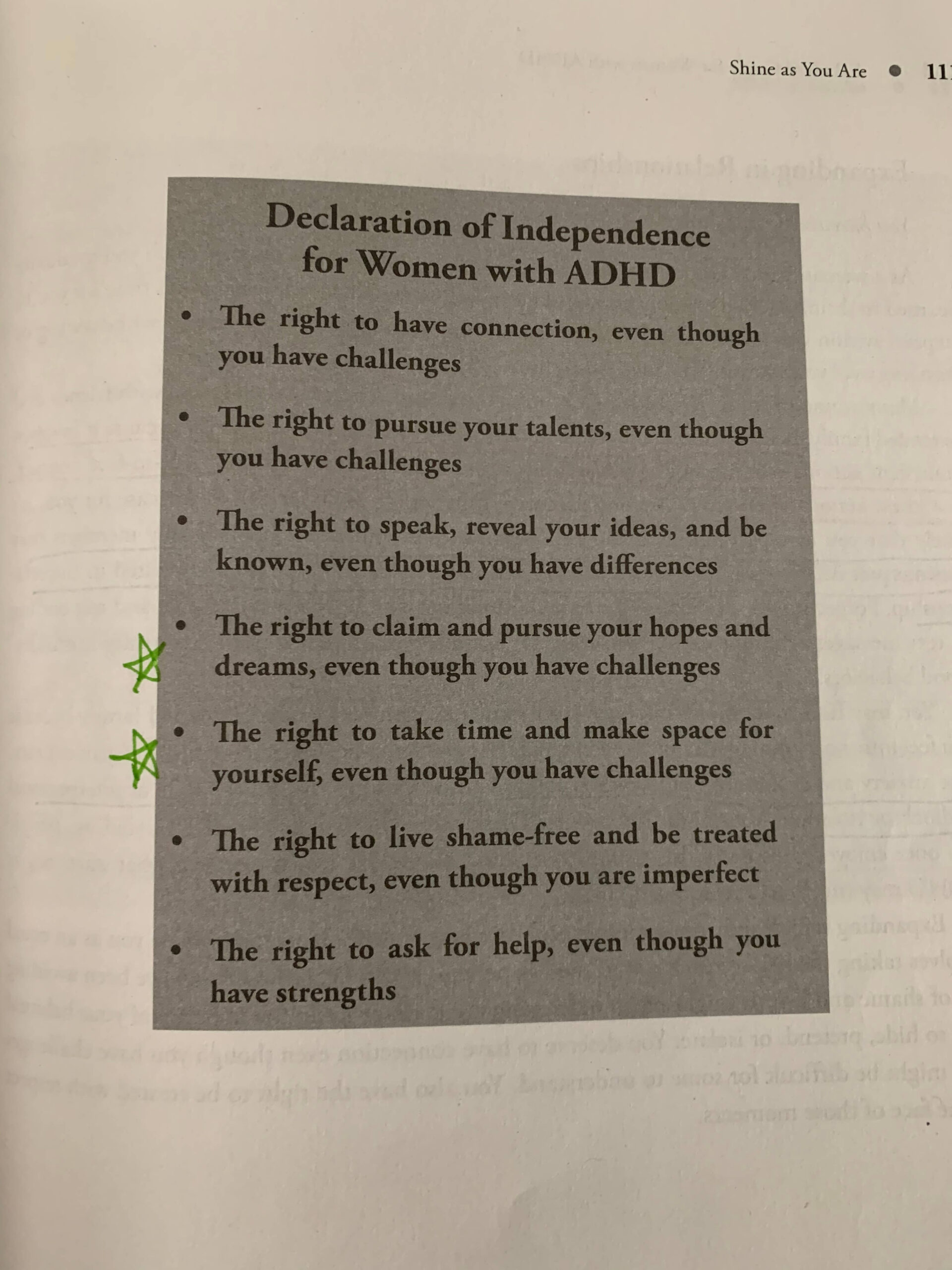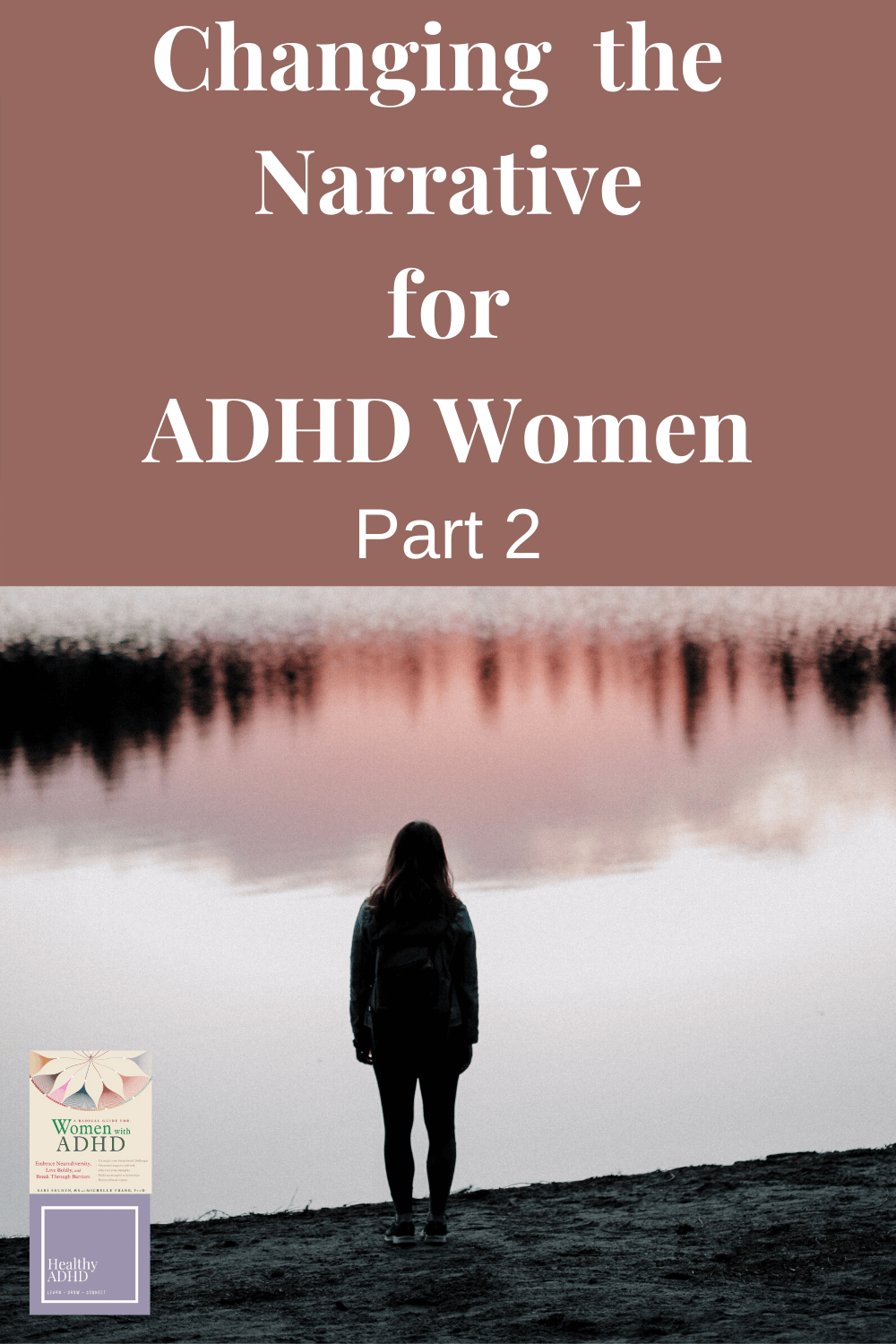Changing the narrative for ADHD women
Part 2
I introduced some of the concepts around changing the narrative for ADHD women in part one of this series. You may want to go back and re-read that before you start this one.
Many of the suggestions here are based on A Radical Guide for ADHD Women. (Affiliate link. See my full disclosure)
ADHD Diagnosis
Maybe you suspect you have ADHD but you haven’t even gotten the diagnosis yet.
You know that something is different, but you aren’t sure exactly what it is.
Either way, I want you to know if you do have ADHD you are part of a large and welcoming tribe.
Often, we are diagnosed with some other more secondary condition before anyone ever considers testing for ADHD. This is partially because so few providers actually understand ADHD and what it looks like.
ADHD in women is often mistaken for major depression and anxiety. While anxiety and depression often accompany ADHD, it is itself a distinct neurological condition.
Many of the symptoms you and I deal with are completely invisible to others.
Other people judge us primarily by our behavior – so if our behaviors don’t align with what is expected, people assume we aren’t trying.
On the other hand, if we do a really good job compensating for our symptoms, they go unnoticed.
Your first major personal hurdle after diagnosis will be acceptance.
The word itself sounds straightforward, but in practice it’s much harder.
Acceptance doesn’t mean giving up. And it doesn’t mean you need to try harder to hide your symptoms.
In the words of the authors, “You don’t have to like your challenges in order to accept them.”
Spend some time thinking about what acceptance means to you.
Limiting beliefs
I have written extensively about limiting beliefs, and self-talk in ADHD women.
After years of absorbing negative messaging it’s not uncommon for some of us to develop a distorted world view.
It can be scary to, “come out” as a woman with ADHD and ask for what you need. Hell, it’s scary just to give our struggles a name.
It doesn’t feel safe to reveal that much of ourselves because we’ve received a lot of criticism and questioning.
This leads to a seriously mixed up sense of self. We aren’t LIKE other women, and we can feel it in our bones.
Little things feel like big things.
A messy desk means, “I am a mess.” Which can easily be translated in your thoughts to, “I’m bad.” Or even. “I’m not enough.”
When we repeat these thoughts over and over in our minds we do start to believe them. This leads limiting beliefs and hiding behaviors.
Hiding in plain sight
Most ADHD women will admit they live in hiding. We not only hide the diagnosis itself, but we hide all of the other parts of ourselves that matter.
We become invisible when we try to, “pass” for neurotypical.
It can be embarrassing to be forgetful, or to ask someone to repeat themselves.
It’s also difficult to reconcile our desire to be productive with the mental exhaustion that comes from just getting through the day.
Things that look easy for other women feel much harder for us.
I started a website because it was much easier to hid behind a computer screen and research ADHD that way, than to make videos, or become a social media maven.
I wanted to do good work, and I even wanted to be known for it, but I was unwilling to put my face next to my work.
I was afraid somebody would call me out for not having a PhD. Or they might ask, “What makes you qualified to run a support group? You’re not a coach!”
So I hid. I’m getting better at letting the world see me, but I still have issues owning the work I do in the world, or asking to be paid.
There is a sense of powerlessness that happens to so many ADHD women.
We are afraid to reveal our true desires and goals for fear of judgment. And most of us have stumbled in the past, so the fear of failure is real.
But Hiding exacts a price. We miss out on something every time we decline an invitation, or don’t use our voice.
We miss the chance to show the world that ADHD or not, we deserve to be here. And we bring an enormous set of strengths with us to the table.
Learning to dream
You might find the idea of opening up about who you are quite frightening, or even impossible.
I know the feeling. It’s hard to believe that you might be able to really be yourself in a public way without repercussions.
You can probably list every single one of your struggles. But it’s much harder to talk about the personal traits that make you, YOU.
Sometimes after years of negative patterns we lose sight of our hopes, dreams, and visions. Or we might not think we even deserve to have them.
When I was young I was criticized for being too daydreamy and called a, “space cadet.”
Like me, perhaps you quit dreaming? Or you quit believing is was ok to have dreams?
This is problematic because without a sense of purpose the ADHD brain is dead in the water.
“Compelling visions and a sense of purpose stimulate and activate us, which is crucial for adults with ADHD whose brains crave and require input that is highly stimulating.” (p. 73)
It is crucial that we allow ourselves to dream, and to explore the things that light us up, without judgment, and with a sense of curiosity.
Not every childhood dream is worth holding onto, but what we learn about ourselves in the process is invaluable.
We are creating a more integrated picture of ourselves, separate from our struggles.
Restoring wholeness
You can begin to see yourself as a whole person without sugarcoating your ADHD struggles or convincing yourself that it’s a gift.
This is the time to re-examine some of the parts of you that have been ignored, misunderstood, or even stifled.
When we engage is black/white thinking by overemphasizing one aspect of ourselves, we are engaging is what the authors call reductive thinking – which is defined as oversimplifying a complex idea to the point of distortion.
When we think like this we don’t even stop to appreciate all sides of who we are.
Pause for a moment and reflect on what makes you, YOU.
What do you do really well, that comes easily?
What skills have you developed over the years?
What special qualities have you always embodied? (determination, humor, perspective etc)
With the constant mental chatter of ADHD you might have trouble setting priorities.
In the Radical Guide, Sari and Michelle discuss creating a personal mission shaped by your values. (Affiliate link. See my full disclosure)
There is a reflection in the book to help you form a personal mission statement as well. (p. 97)
In order to form an integrated sense of self we must*** zero in on our values.
Here is a link to my post on setting priorities and examining your values.
Get Comfortable with Being Seen
Imagine for a moment that you really do deserve to be the central character in your life.
Your words, actions, and experiences are valid. No questioning or resisting that truth.
You might have challenges but that doesn’t mean you don’t deserve a fulfilling life.
You deserve to be seen.
Check out the Declaration of Independence for ADHD Women pictured below.

How can you expand your sense of self in relationships?
We both know it’s hard to maintain relationships, but we certainly have a right to try. Whether you have waited too long to return a call, or you directly avoided contact – think about ways to connect.
How can you use your voice?
Many of us hide our strengths or don’t talk about our accomplishments because we think they pale in comparison to our differences. But you deserve a seat at the table, you don’t need to hold back.
It is safe to be more of who you are.
Growing into a bigger, brighter version of yourself takes time. Small steps each day make a huge difference in the long term.
Think of it like a 3000 piece puzzle. Every day you find another piece and over time a clearer, more beautiful image is going to emerge.
Maintaining authenticity
Authenticity is a tricky word. It’s hard to define, and in my experience people who throw the word around are often the opposite.
The authors of the radical guide outline a process of noticing the emotional cues, physical sensations, and behavior changes that occur when we are out of alignment with ourselves.
Think of an experience that left you agitated, and feeling angry or helpless. A time when you knew*** with every ounce of your being that something was off.
I know I am behaving in a reactive way when my mind goes blank, and I start to feel flushed and tight in my abdomen. I feel negative and sad, and I often don’t sleep well the day it happens.
There is a shift when we fall out of alignment. It’s emotional and physical.
When this happens we can learn to check-in with ourselves using the three steps outlined in the book. (pg 159)
Treatment options
Part of the journey of ADHD is figuring out how you want to treat your symptoms.
Since you and I have different symptoms that show up in different contexts, we need different types of treatment. No two people are alike, and no two ADHD people are alike either.
Traditionally, medication and strategies are what we think of as treatment.
Both are fine, but neither can be applied with a “fix-it” mentality and actually be successful.
It’s really about finding a combination of tools, and then untangling some of the identity issues that I’ve discussed in this article.
There will be days when asking for help, and receiving it, feels impossible.
Sometimes you won’t even be able to identify what you are feeling. Intense emotions are one of the most common symptoms of ADHD, and one of the hardest to manage day-to-day.
Changing the narrative is about becoming MORE of who you are, without hiding the parts that you aren’t as comfortable with.
You also need to practice managing your expectations. As in, don’t compare yourself to neurotypicals or other women with ADHD. The more you compare yourself the more distorted your self-image will become.
A couple of ideas for managing treatment:
-
Don’t give too much attention to social media
-
Prioritize information from qualified professional therapists/doctors/coaches/mentors
-
Take a break when you need it, manage your energy
-
Be open to trying medications, therapy
-
Try body doubling and connecting with other women who get it
-
Avoid environments where misinformation runs rampant (like facebook)
-
Accept support and help, at home and at work
-
Practice assertive communication and setting boundaries
-
Keep your sense of humor
ADHD women: It’s time to change the narrative.
In the words of Sari and Michelle, “Brave, bright, bold women with ADHD live within connection and lift each other up because we know one thing for certain: You can’t do ADHD all by yourself.”
You don’t have to do it alone. And you don’t even have to spend a ton of money. You can learn from other ADHD women who, “get it.”
In the Enclave I help women understand their emotions and improve their relationships, so they can have calmer, and more satisfying lives.
Lets change the narrative together.



